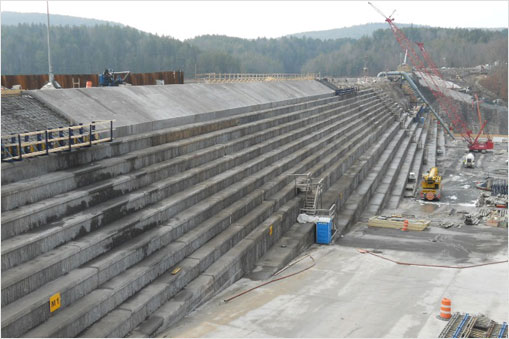 December 11, 2013 CONTACT: Adam Bosch (845) 334-7868 Department of Environmental Protection Announces That Rehabilitation of Gilboa Dam is Two Years Ahead of ScheduleOriginally Projected for 2016, Dam Rehabilitation Now Expected to be Completed Next YearNew York City Department of Environmental Protection (DEP) Commissioner Carter Strickland today announced that the $400 million full-scale rehabilitation of Gilboa Dam is two years ahead of schedule after an extremely productive construction season in 2013. Since the project began, approximately 87,500 cubic yards of concrete have been added to the face of the dam, which is now 80 percent complete. That includes 54,000 cubic yards that were placed in 2013 alone. Workers have also completed 12 of the 14 concrete slab sections below the dam’s spillway, and installed post-tensioned anchors and structural concrete at the west training wall. Similar work at the east training wall is also nearing completion. The rehabilitation, originally projected to be completed in 2016, is now expected to be substantially complete by the end of summer 2014. “The expedient and careful rehabilitation of Gilboa Dam is a testament to the skill of the engineers and the construction workers who’ve been involved in the project, including roughly 125 tradesmen from across the watershed,” Strickland said. “This project is important for the City and our neighbors in the Catskills, as it will ensure the reliability of the water supply and the safety of critical infrastructure at Schoharie Reservoir.” In 2006, a 220 foot long by 5.5 foot deep notch was cut from the top of the westernmost portion of the dam in order to lower water levels and allow for the installation of 80 anchoring cables into the top and outer face of the dam. The cables were drilled through the dam and into the bedrock below to anchor it in place. In 2008 work began to add a system of rigid, movable gates which now span the 220 foot notch and provide the flexibility to release water and create excess storage capacity within the reservoir. To help further regulate water levels, earlier this year two temporary siphons were installed to carry water over the spillway and into the creek below. This provides work crews with access to portions of the dam that might otherwise be obstructed by water. The siphons will later be replaced by a new diversion tunnel, which will allow water to be released from the reservoir, around the dam, and into Schoharie Creek. The diversion tunnel is expected to be finished by 2020. Gilboa Dam was built from 1919 to 1927 and impounds Schoharie Reservoir, the northernmost reservoir in the City’s Catskill water supply system, which at full capacity can hold 17.6 billion gallons of water. The original stone face of the dam had been damaged by years of freezing and thawing, which caused some of the stone to weaken and dislodge. Once complete, the rehabilitation project will reinforce the dam with roughly 234 million pounds of concrete, further improving its structural integrity. The new concrete face will be carefully molded to look like stone. Reconstruction of the dam is the largest public works project in Schoharie County, and one of the largest in the entire Catskills. DEP manages New York City’s water supply, providing more than one billion gallons of water each day to more than nine million residents, including eight million in New York City. The water is delivered from a watershed that extends more than 125 miles from the city, comprising 19 reservoirs and three controlled lakes. Approximately 7,000 miles of water mains, tunnels and aqueducts bring water to homes and businesses throughout the five boroughs, and 7,500 miles of sewer lines and 96 pump stations take wastewater to 14 in-city treatment plants. DEP has nearly 6,000 employees, including almost 1,000 in the upstate watershed. In addition, DEP has a robust capital program, with a planned $14 billion in investments over the next 10 years that will create up to 3,000 construction-related jobs per year. This capital program is responsible for critical projects like City Water Tunnel No. 3; the Staten Island Bluebelt program, an ecologically-sound and cost-effective stormwater management system; the city’s Watershed Protection Program, which protects sensitive lands upstate near the city’s reservoirs in order to maintain their high water quality; and the installation of more than 820,000 Automated Meter Reading devices, which will allow customers to track their daily water use, more easily manage their accounts and be alerted to potential leaks on their properties. For more information, visit nyc.gov/dep, like us on Facebook at facebook.com/nycwater, or follow us on Twitter at twitter.com/nycwater. | ||